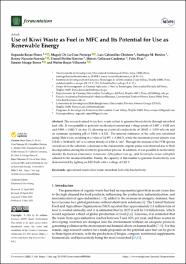Use of Kiwi Waste as Fuel in MFC and Its Potential for Use as Renewable Energy

View/
Download
(application/pdf: 1.983Mb)
(application/pdf: 1.983Mb)
Date
2023-04-12Author(s)
Rojas-Flores, Segundo
De La Cruz-Noriega, Magaly
Cabanillas-Chirinos, Luis
Benites, Santiago M.
Nazario-Naveda, Renny
Delfín-Narciso, Daniel
Gallozzo-Cardemas, Moisés
Murga-Torres, Emzon
Rojas-Villacorta, Walter
Díaz, Felix
Metadata
Show full item recordAbstract
This research aimed to use kiwi waste as fuel to generate bioelectricity through microbial fuel cells. It was possible to generate an electrical current and voltage peaks of 3.807 ± 0.102 mA and 0.993 ± 0.061 V on day 11, showing an electrical conductivity of 189.82 ± 3.029 mS/cm and an optimum operating pH of 5.966 ± 0.121. The internal resistance of the cells was calculated using Ohm’s Law, resulting in a value of 14.957 ± 0.394 Ω, while the maximum power density was 212.68 ± 26.84 mW/m2 at a current density of 4.506 A/cm2. Through the analysis of the FTIR spectra carried out on the substrate, a decrease in the characteristic organic peaks was observed due to their decomposition during the electricity-generation process. In addition, it was possible to molecularly identify the bacteria Comamonas testosteroni, Sphingobacterium sp., and Stenotropho-monas maltophila adhered to the anodized biofilm. Finally, the capacity of this residue to generate bioelectricity was demonstrated by lighting an LED bulb with a voltage of 2.85 V.
Collections
- Web of Science (WOS) [236]

